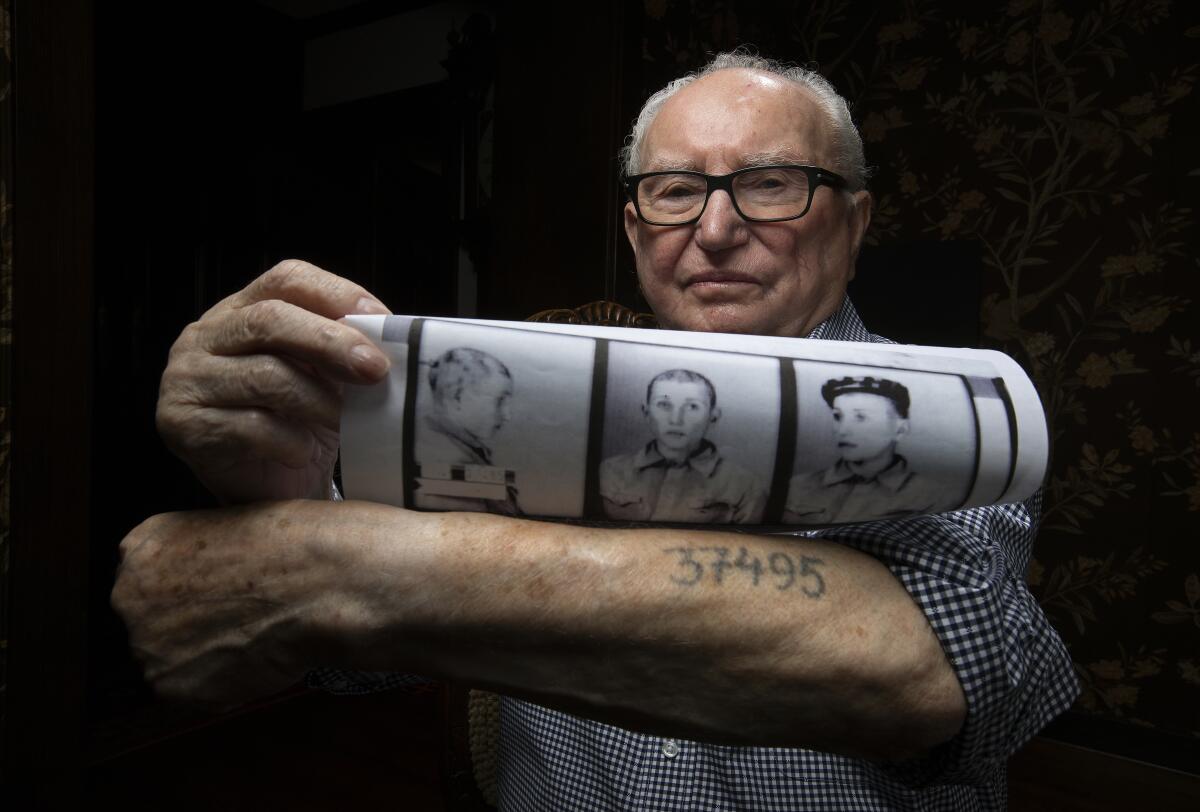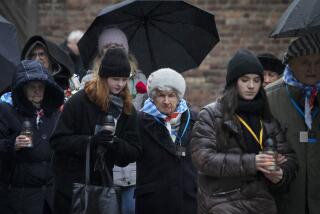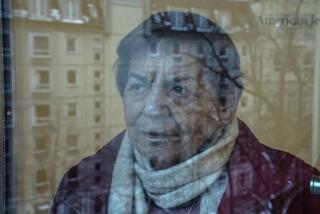Rachmil ‘Ralph’ Hakman, who survived Auschwitz and kept going back, dies at 95

Before he left in January for his fourth return to the Auschwitz-Birkenau prison camp where he labored as a teen, Ralph Hakman explained why he wanted to go back to the site of the worst years of his life.
“I would be guilty not to go.... What if these are my last chances?” he said in an interview with The Times, which published an account of his journey to the death camps on the 75th anniversary of their liberation.
Hakman was right.
Fifty-five days after he stood to pray with more than 100 survivors in front Birkenau’s “death’s gate” — where cattle cars once arrived to dump Jews into gas chambers — he died Sunday afternoon at his Beverly Hills home.
Hakman had just celebrated his 95th birthday.
Born Rachmil Hakman on March 11, 1925 as a middle child in an Orthodox Jewish family of 10 kids, Hakman never imagined life being far different than that of his parents, who ran a kosher butchery. At the time, a third of the 81,000 residents of Radom, a Polish town near which he lived, were Jewish.
Everything changed when German soldiers invaded.
It was Sept. 8, 1939.
He was 14.
Gone were the Jewish schools, synagogues and his father’s ability to work freely. In 1941, Nazis set up two ghettos, including one that surrounded the family’s two-room house in suburban Glinice. Hakman’s father, Yitzhak, was arrested in a roundup of Jews the next year. After he escaped, family members went into hiding. Police caught an older sister and her 2-year-old.
Hakman’s mother, Rose, approached him with an idea.
“If you turn yourself in, they will let your sister and the baby go.”
He arrived in Auschwitz in a tightly packed train. His head was shaved, his face was bruised, and he was marked with identification tattoos as the Nazis took away his name: 37,495.
It was June 6, 1942.
He was 17.

They sent him to Birkeau three days later.
Hakman survived in the camp for three years.
“The jobs were fake, just to keep us busy,” he said in January as he described the time he was assigned to dig trenches when a Nazi suddenly beat his head with the butt of a rifle. It split open to his skull. He suffered from back pain much of his life after a Nazi lashed him 25 times with the wooden handle of a pickax for being caught with extra bread.
Hakman’s last job was to staff the bathhouse, where new prisoners who were not immediately put to death undressed and showered before putting on striped uniforms. It was 75 feet from the gas chambers.
In 1945, Allied powers closed in. Nazis sent prisoners on death marches. Hakman’s group made it to Grafenberg, Germany, where they dug trenches until a small group escaped that spring. On May 6, he ran into a Russian soldier on a bike who said the Nazis had lost. Germany officially surrendered on May 8.
He was 20.
Back in Radom, Hakman learned that his parents and every sibling but one — an older sister who fled to Russia — was killed.
In a displaced persons camp in Feldafing, Germany, he met a second-cousin named Esther for the first time. They moved together to a displacement camp in Stuttgart, Germany. In 1949, Hakman received approval to resettle in the U.S. He landed in Indianapolis, where he found work at the Stark and Wetzel packinghouse and adopted the nickname Ralph.
When he visited Esther that year in Toronto, she met him at the train station and told him she had found a tailor to make a suit.
“Just like that, she told me we were going to get married!” Hakman said earlier this year with a laugh. On Dec. 31, 1949, they did just that.
Esther gave birth to a son in Indianapolis in 1956. A year later she and Hakman moved to Los Angeles where he cofounded Jersey Meat Provision, a meat storage company. They had a daughter soon after.
The Hakmans lived in Beverly Hills when communities of Holocaust survivors on the Westside thrived, with picnics in Roxbury Park, group vacations to Lake Elsinore and organizations like the Radomer Society and 1939 Club.

“We’re really not normal people, us survivors,” Hakman said in January. “So we had to be around each other because we understood.”
It’s the same reason he kept returning to meet other survivors who visited the former concentration camp, first in 1983 with his kids, then in 2010, a year after Esther died of cancer at 82. He came back again in 2015 after marrying Barbara Zerulik, who he met through the survivor networks. Zerulik, who lived in Florida at the time, was visiting her sister and brother-in-law, who was also a survivor from Radom.
“Going back this last time helped him complete his journey in the way he always wanted to do,” said Zerulik, 88, who joined Hakman in Poland in January. Hakman had planned to return again this spring be part of a documentary film.
As more survivor friends died and he worked less frequently, he connected to his past by telling his story. Each month, he would talk with college students or tour groups visiting the Los Angeles Museum of the Holocaust.
“It’s my responsibility to share what happened,” Hakman said. “To make sure it doesn’t happen again.”
His last public testimony was on Jan. 26 in Krakow during a World Jewish Congress observation of the liberation anniversary.
Hakman’s family has asked for donations to be made to the L.A. Holocaust museum in his name.
Because of restrictions on gatherings during the coronavirus outbreak, the family is unable to have a traditional funeral.
“We have decided we will have something befitting my father when this crisis passes — and G-d willing that will be soon,” his daughter Deborah wrote in an email. “We will have a memorial when possible so all who loved him and he loved can honor his memory.”
More to Read
Start your day right
Sign up for Essential California for the L.A. Times biggest news, features and recommendations in your inbox six days a week.
You may occasionally receive promotional content from the Los Angeles Times.







